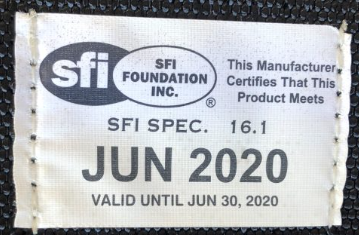Sign up now to join the JEGS email newsletter and be the first to learn about new products, special deals and e-mail only offers!

If you’re planning on participating in any car racing events, then you’ll surely need a helmet. But not just any helmet will do; it must meet specific safety standards and regulations designed to provide maximum protection in case of a crash.
Thankfully, organizations like the Snell Memorial Foundation and the Fédération Internationale de l'Automobile (FIA) have set strict guidelines to ensure helmets offer the highest level of safety. These standards are continually updated to incorporate the latest in safety technology and research findings.
To ensure you’re prepared for your next 2024 event, this article covers everything you need to know about the different ratings and regulations for car racing helmets.
Let’s get started.
We’ll first explore Snell and FIA certification in more detail so you know which applies to you.
The Snell Memorial Foundation is known for its rigorous helmet certification standards, often considered among the most stringent in the world. Snell standards are updated approximately every five years, with the latest iteration being the SA2020 standard.
These certifications focus on various aspects of helmet safety, including impact testing, penetration resistance, and retention system effectiveness. Helmets that meet Snell standards have undergone extensive testing to ensure they offer superior protection.
While not mandatory for all racing organizations, Snell certification is highly respected and often preferred by serious racers for its commitment to high safety standards.
FIA is another key player in motorsport safety, setting standards for all sorts of racing gear, including helmets. FIA certification standards are tailored to professional motorsport levels, focusing on advanced safety technologies and materials.
Unlike Snell, which primarily serves the North American market, FIA standards have a broader international application, making them a must-have for global racing events.
FIA periodically updates its standards to reflect new safety research and technological advancements, with the 8860 and 8859 series being among the most stringent for helmet safety. These cover impact absorption, penetration resistance, and include specific requirements for visor performance against debris and fire resistance.
The Snell or FIA certification decal is found attached to the inside of the helmet, underneath the cushioned liner. By carefully pulling the inner liner away from the helmet, the sticker will be visible and you can then confirm which certification it has.
Sign up now to join the JEGS email newsletter and be the first to learn about new products, special deals and e-mail only offers!

As mentioned, helmet ratings Snell are updated every five years and expire 12 years from the Snell Year. With the latest being 2020’s SA2020 (SA for cars, M for motorcycles), helmet, which will expire on January 1st, 2032.
Note: Always check with the rulebook for your racing sanctioning body regarding which helmet ratings are prohibited and which are valid as requirements and regulations will be different.
Snell 2015 expires on 1/1/2027
Snell 2020 expires on 1/1/2032
All other Snell-rated helmets are prohibited for NHRA events.
Unlike Snell approved helmets, FIA does not update its requirements every five years There are currently two FIA standards that are still good in 2024. These are the 8860-2018, known for its exceptionally high protection level, and the FIA 8859-2015, suitable for most motorsport disciplines.
FIA 8860-2010 expires 1/1/2028
FIA 8860-2015 expires 1/1/2033
FIA 8860-2018 expires 1/1/2036
All other FIA-rated helmets are prohibited for NHRA events.
For the 2024 helmet safety guidelines, it's important to understand how Snell and FIA standards improve safety. Here's a breakdown of key features based on these guidelines:
When considering a helmet upgrade, it's important to assess the latest in safety standards and technology advancements.
With Snell releasing new standards every five years and FIA continually evolving its requirements, staying updated ensures you benefit from the most recent safety innovations. The transition from older standards, such as Snell SA2015 to SA2020, can offer major improvements in protection, comfort, and performance.
Upgrading your helmet is not just about meeting regulatory compliance; it's about enhancing your safety on the track. Modern helmets incorporate advanced materials for better impact absorption and fire resistance, improved aerodynamics for less fatigue, and superior ventilation systems to keep you cool under pressure.
What’s more, compatibility with other safety gear, like HANS devices, is seamlessly integrated into newer models.
Before making a purchase, consider helmets certified to the latest standards relevant to your racing discipline. This ensures you are investing in equipment that offers the best available protection.
Having made it this far, you should now be able to confidently choose the best helmet for your racing discipline, whether it requires Snell or FIA certification.
For a massive selection of Snell and FIA approved helmets, consider JEGS, a leading supplier of performance auto parts and accessories, including racing gear. Complete your order online and have your gear sent straight to your doorstep.
Still have questions? Contact our team today.



